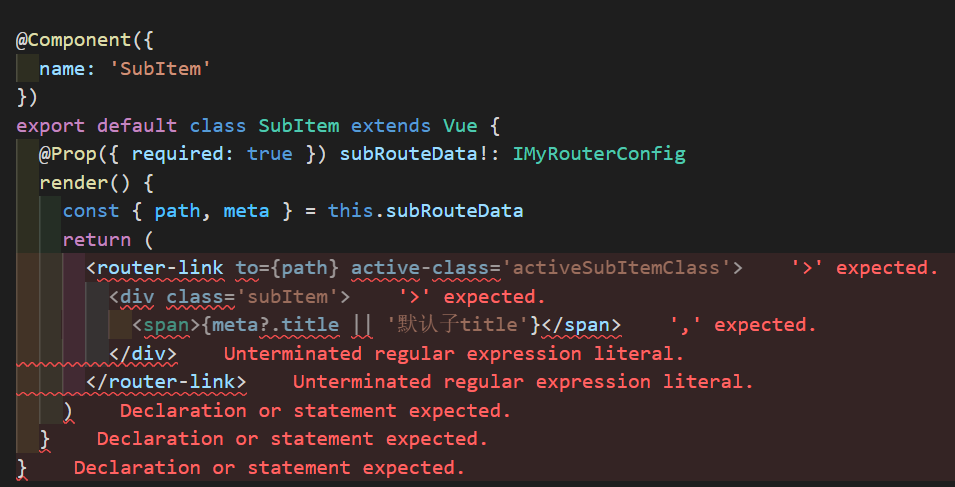# 笔记
# 2022 年 2 月 1 日
# 类型断言
类型断言相当于告诉/指定 TypeScript 编译器某个值的类型
类型断言好比 JS 中的类型转换,但是不进行特殊的数据检查和解构。 它不会在运行时影响,只是在编译阶段起作用。
类型断言的两种方式:
// “尖括号”语法
let someValue: any = "this is a string"
let strLength: number = (<string>someValue).length
// as语法
let someValue: any = "this is a string"
let strLength: number = (someValue as string).length
两种使用形式是等价的,但在 TypeScript 里使用 JSX 时,只有 as 语法断言是被允许的。
# 2022 年 2 月 2 日
# vuex-class 中使用 module
vuex 中使用 module,需要指定 namespaced 为 true
使用 State 访问 module 中的属性时,需要指定 namespace,有以下两种方式引用。前者适合需要多次使用同一个 module 的情况
import { State, namespace } from "vuex-class"
const userModule = namespace("user")
export default class Home extends Vue {
@userModule.State userInfo!: IUserInfo
}
// 或
import { State, namespace } from "vuex-class"
export default class Home extends Vue {
@namespace('user').State userInfo!: IUserInfo
}
# 2022 年 2 月 3 日
# Computed Properties In Class-Component
使用 vue-class-component 后,已取消了 computed 选项,可以通过声明类属性 getter/setter 来代替
import Vue from "vue"
import Component from "vue-class-component"
@Component
export default class HelloWorld extends Vue {
firstName = "John"
lastName = "Doe"
// Declared as computed property getter
get name() {
return this.firstName + " " + this.lastName
}
// Declared as computed property setter
set name(value) {
const splitted = value.split(" ")
this.firstName = splitted[0]
this.lastName = splitted[1] || ""
}
}
# 2022 年 2 月 4 日
# vue-class-component Hooks
使用了 vue-class-component 后,仍然可以正常使用 vue 选项,但不能在实例上调用它们,并且在声明方法时,避免使用这些保留名称
import Vue from "vue"
import Component from "vue-class-component"
@Component
export default class HelloWorld extends Vue {
// Declare mounted lifecycle hook
mounted() {
console.log("mounted")
}
// Declare render function
render() {
return <div>Hello World!</div>
}
}
# 2022 年 2 月 5 日
# Additional Hooks
使用了 vue-class-component 后,如果需要使用如:beforeRouterEnter (Vue Router 插件) 等 Vue 插件提供的额外的方法的话,需要使用 Component.registerHooks 去注册这些钩子
// class-component-hooks.js
import Component from "vue-class-component"
// Register the router hooks with their names
Component.registerHooks(["beforeRouteEnter", "beforeRouteLeave", "beforeRouteUpdate"])
注意在 main.js 中的引入位置
// main.js
// Make sure to register before importing any components
import "./class-component-hooks"
import Vue from "vue"
import App from "./App"
new Vue({
el: "#app",
render: h => h(App)
})
之后,就可以正常使用相关方法了
# 2022 年 2 月 21 日
# ES6 Class 的基本语法
ES6 的 class 可以看作是一个语法糖,它的绝大部分功能,ES5 都可以做到,新的 class 写法只是让对象原型的写法更加清晰、更像面向对象编程的语法。
下面的代码表明,类的数据类型就是函数,类本身就指向构造函数。
class Point {
// ...
}
typeof Point // "function"
Point === Point.prototype.constructor // true
this指向问题
类的方法内部如果含有 this,它默认指向类的实例。使用时需要注意,可能会报错
class Logger {
printName(name = "there") {
this.print(`Hello ${name}`)
}
print(text) {
console.log(text)
}
}
const logger = new Logger()
const { printName } = logger
printName() // TypeError: Cannot read property 'print' of undefined
- 静态方法
类相当于实例的原型,所以在类中定义的方法,都会被实例继承。如果在方法前增加 static 关键字,就表示该方法不会被实例继承,需要通过类来调用
class Foo {
static classMethod() {
return "hello"
}
}
Foo.classMethod() // 'hello'
var foo = new Foo()
foo.classMethod()
// TypeError: foo.classMethod is not a function
如果是在静态方法里面调用 this 关键字,那么 this 指向这个类,而不是实例。另外,静态方法可以与非静态方法重名
- 私有属性的提案
目前有一个提案,为 class 添加私有属性。方法是在属性名之前,使用 # 表示
class Foo {
#a
#b
constructor(a, b) {
this.#a = a
this.#b = b
}
#sum() {
return this.#a + this.#b
}
printSum() {
console.log(this.#sum())
}
}
# 2022 年 2 月 22 日
# JSX in vue-class-component
vue-class-component (opens new window) 官方文档上说明: data, render and all Vue lifecycle hooks can be directly declared as class prototype methods as well,但在实际使用时,发现 render 选项时会报错

目前发现可以通过以下几种方式调整:
script lang="ts将lang=ts去掉后可以继续使用vue-class-component- 取消使用
vue-class-component,改为用vue原生写法 - 设置
lang=jsx,但这种情况下style会无效,并且vue的其他选项可能会受到影响
其他参考:
- Stackoverflow (opens new window)
- Github (opens new window)
- https://medium.com/@hayavuk/using-jsx-with-vue-js-and-typescript-d6963e44de48 (opens new window)
# 2022 年 2 月 23 日
# type 与 interface 的异同
type(类型别名)和 interface(接口)非常相似,在很多情况下可以自由选择。接口的几乎所有特性在类型中都是可用的,主要有以下几点区别
interface可以extends、implement,而type不允许。但是type可以通过交叉类型实现这两者的行为。type可以与type、interface进行类型交叉
interface IUser {
name: string;
}
type person = IUser & {
age: number
}
type可以声明基本类型别名,联合类型,元组等类型,而interface对值所具有的结构进行类型检查
// 基本类型别名
type Name = string
// 联合类型
interface Dog {
wong();
}
interface Cat {
miao();
}
type Pet = Dog | Cat
// 具体定义数组每个位置的类型
type PetList = [Dog, Pet]
type不能重新打开以添加新属性,而interface总是可扩展的(关键区别)。例子如下:
// Adding new fields to an existing interface
interface Window {
title: string;
}
interface Window {
ts: TypeScriptAPI;
}
const src = 'const a = "Hello World"'
window.ts.transpileModule(src, {})
// A type cannot be changed after being created
type Window = {
title: string
}
type Window = {
ts: TypeScriptAPI
}
// Error: Duplicate identifier 'Window'.
总的来说,一句话:能用 interface 用 interface,不能用就换 type
参考文档:
- https://github.com/SunshowerC/blog/issues/7 (opens new window)
- typescriptlang.org (opens new window)
# 2022 年 2 月 24 日
# 在 vue.config.js 中引入 ts 文件中的变量
TODO
# 2022 年 2 月 28 日
# ES6 Class 的继承
为什么子类的构造函数,一定要调用super()`?
原因就在于 ES6 的继承机制,与 ES5 完全不同。ES5 的继承机制,是先创造一个独立的子类的实例对象,然后再将父类的方法添加到这个对象上面(原型链继承)。ES6 的继承机制,则是先将父类的属性和方法,加到一个空的对象上面,然后再将该对象作为子类的实例。这就是为什么 ES6 的继承必须先调用 super()方法,因为这一步会生成一个继承父类的 this 对象,没有这一步就无法继承父类。注意,这也意味着新建子类实例时,父类的构造函数必定会先运行一次。
super关键字
super作为函数调用时,代表父类的构造函数。super作为对象时,在普通方法中,指向父类的原型对象;在静态方法中,指向父类。- 由于
super指向父类的原型对象,所以定义在父类实例上的方法或属性,是无法通过super调用的。
class A {
constructor() {
this.p = 2
}
}
class B extends A {
get m() {
return super.p
}
}
let b = new B()
b.m // undefined